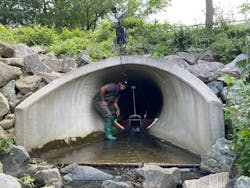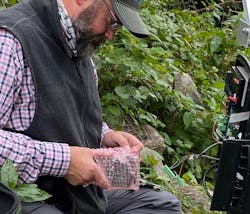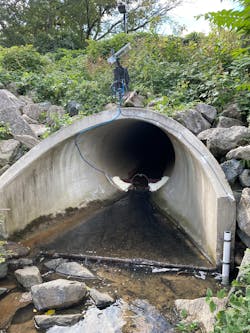Dr. Marccus Hendricks grew up in an inner-city community in Dallas plagued by poor air and water quality. His sister was severely affected by asthma, and his childhood home was flooded on multiple occasions because of inadequate stormwater infrastructure.
Now an assistant professor at the University of Maryland School of Architecture, Planning and Preservation, Hendricks has held on to those lived experiences. They came to the fore as he pursued his PhD in urban and regional science. And he finds they lend clarity and purpose to his current research on stormwater infrastructure planning, social vulnerability to disaster, environmental justice, hazard mitigation, public health, and the built environment.
“The idea was to create a living laboratory,” says Hendricks. “Data collected from multiple locations on our 1,335-acre campus could be used to address both short-term responses and longer-term restoration projects that would improve water quality, maintain regulatory compliance, and enhance the sustainability and resilience of the university’s built environment.”
Hendricks was eager to bring his expertise in infrastructure planning and management, disaster vulnerability, and hazard mitigation to bear on the project, but first, he needed the data.
“I understood the sustainability and risk assessment piece, but we needed the technology piece—the strategically deployed sensors—to give us a real-time view of the actual water quality and quantity at various outfalls,” he says.
Expertise, Equipment, and Iteration
Hendricks secured $43,000 in seed funding from the university’s Sustainability Fund—no small feat in itself—and began his search for a contractor to install a stormwater monitoring network. After spending what he admits was an inordinate amount of time researching different firms, he followed up on a referral from a colleague and secured the services of Lower 48 Instruments out of Dayton, OH. Lower 48 Partner Chris Davis, a seasoned pro, was impressed by the scope of the project.
“They’re doing more than just checking the box on compliance,” says Davis. “There’s a genuine interest in collecting good data and actually using that data to make significant improvements to stormwater infrastructure.”
For the project, Davis selected an array of equipment from In-Situ. He installed three Aqua TROLL 500 Multiparameter Sondes to collect data on pH, turbidity, and dissolved oxygen; three In-Situ Mace Area/Velocity sensors to monitor flow; and three In-Situ Mace FloPro XCi boxes to control and log the sondes and sensors.
In-Situ, a global company based in Colorado, acquired the Australian flow meter manufacturer, Mace, in 2017, and Davis has been using equipment from both companies for years.
The system also includes a WebComm card integrated telemetry that provides remote access to the Aqua TROLL 500s and the Area/Velocity sensors. Davis, Hendricks, and others can view the data at any time on their computers or smartphones using HydroVu, In-Situ’s subscription-based data services platform, with options for alerts, alarms, and a full suite of data-visualization and management tools.
“That remote access is essential,” says Davis. “With installations all around campus, manual data collection would be prohibitively time-consuming and expensive.”
With the equipment in place, early assessments revealed that stormwater on campus was not moving as expected and more information was needed to understand the flows over time. Hendricks’ initial underestimation of flow in some areas caused a few issues early on.
“The sheer power of even every day rain events caused some weirs to blow out and problems with the equipment,” he says. “But with those sites reinforced, we’re now starting to see that valuable baseline data come in.”
Where Mitigation Planning Meets IoT
In addition to managing the stormwater project and navigating teaching responsibilities in the time of COVID, Hendricks also leads the university’s Stormwater Infrastructure Resilience and Justice (SIRJ) Lab. Established under his leadership, the lab fosters research focused on flood risks and how communities can adapt to and address barriers within the human-built environment to mitigate disastrous results when stormwater runoff overwhelms existing infrastructure.
He sees opportunities for greater community resilience and environmental justice in the intersection between built-environment planning and IoT technology applied to environmental data collection and transmission.
“When we take this step-by-step, multipronged approach that blends human expertise and analysis with technology, we get a result truly reflective of what’s happening in the community both in terms of scientific data and lived experience, and that’s a powerful framework for constructive improvement,” he says.
Opportunities to Teach and to Lead
On the tech side of things, Chris Davis, from Lower 48, says the In-Situ equipment will collect baseline data for the next year or so to give the team a complete picture of the quality and quantity of stormwater flows.
“It’s a great project,” he adds. “The campus is large enough with enough different land uses that we’re dealing with an actual microclimate, and the whole data collection project also becomes an opportunity for participating students, who are learning fieldwork and data analysis techniques.”
Though currently challenged by the pandemic, Hendricks does indeed plan to involve students throughout the project.
“I’d like students to participate in every phase, from working with the data analysis and visualizations to developing the treatment, green-infrastructure, and restoration plans that will improve our stormwater management,” he says.
Stormwater management is typically viewed with an eye toward storms that happen once every 50 to 100 years. But the permanent equipment installations, along with campus weather stations, will provide continuous data and put the university on the leading edge of stormwater analysis at a time when extreme weather events are becoming more common.
“We have the ability now to evaluate weather and its impacts on a hyperlocal level,” says Hendricks. “Not only does that help us stay in compliance with our MS4 permit and prepare for the future, it also puts us in a position to lead.
“We’re at a critical time in terms of sustainability and resilience in the face of global environmental problems,” he says. “As a university that prides itself on being innovative and environmentally aware, we can and should set an example for the broader community. This project positions us to do that.”









